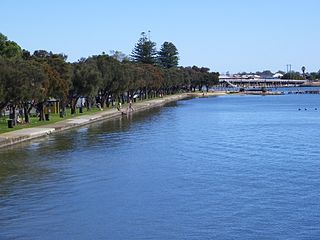
Bunbury is a coastal city in the Australian state of Western Australia, approximately 175 kilometres (109 mi) south of the state capital, Perth. It is the state's third-largest city after Perth and Mandurah, with a population of approximately 75,000.

Mandurah is a coastal city in the Australian state of Western Australia, situated approximately 72 kilometres (45 mi) south of the state capital, Perth. It is the state's second-largest city, with a population of approximately 97,000, ahead of that of nearby Bunbury.

The Peel region is one of the nine regions of Western Australia. It is located on the west coast of Western Australia, about 75 km (47 mi) south of the state capital, Perth. It consists of the City of Mandurah, and the Shires of Boddington, Murray, Serpentine-Jarrahdale and Waroona.
The Armadale railway line is a suburban railway line in Western Australia that runs from Perth to Armadale, and continues as the South Western Railway to Bunbury. The line crosses the Swan River at East Perth via the Goongoongup Bridge, and formerly had crossed it via the Bunbury Bridge.

The Australind is a rural passenger train service in Western Australia operated by Transwa on the South Western Railway between Perth and Bunbury.

Pinjarra is a town in the Peel region of Western Australia along the South Western Highway, 85 kilometres (53 mi) from the state capital, Perth and 21 kilometres (13 mi) south-east of the coastal city of Mandurah. Its local government area is the Shire of Murray. At the 2016 census, Pinjarra had a population of 4910.

North Dandalup is a small town in the Peel region of Western Australia along the South Western Highway between Serpentine and Pinjarra. Its local government area is the Shire of Murray. At the 2011 census, North Dandalup had a population of 346.

South Western Highway is a highway in the South West region of Western Australia connecting Perth's southeast with Walpole. It is a part of the Highway 1 network for most of its length. It is about 406 kilometres (252 mi) long.

The Pinjarra massacre, also known as the Battle of Pinjarra, is an attack that occurred in 1834 at Pinjarra, Western Australia on an uncertain number of Binjareb Noongar people by a detachment of 25 soldiers, police and settlers led by Governor James Stirling. Stirling estimated the Binjareb present numbered "about 60 or 70" and John Roe, who also participated, at about 70–80, which roughly agree with an estimate of 70 by an unidentified eyewitness.

The Shire of Murray is a local government area of Western Australia. It has an area of 1,710.1 square kilometres (660.3 sq mi) and is located in the Peel Region about 80 kilometres (50 mi) south of the Perth central business district.

The South Western Railway, also known as the South West Main Line, is the main railway route between Perth and Bunbury in Western Australia.

The Murray River is a river in the southwest of Western Australia. It played a significant part in the expansion of settlement in the area south of Perth after the arrival of British settlers at the Swan River Colony in 1829.

Mandurah Road is the name given to two roads in the cities of Perth and Mandurah, Western Australia, which link together at Stakehill Road, Karnup.
The Sunday Football League Western Australia, commonly known as the Sunday Football League (SFL), is a defunct semi-professional Australian rules football league that was based in the southern suburbs of Perth, Western Australia. The League was in operation from 1984 to 2008, and Kenwick Royals was the most successful club with eight senior team premierships.
Transport in Perth, Western Australia, is served by various means, among them an extensive highway / freeway network and a substantial system of commuter rail lines and bus routes. Public transport is managed by the Transperth agency.

Transperth Trains is a division of the Public Transport Authority of Western Australia. It is responsible for operating Perth’s urban passenger rail system, as part of the Transperth network.
The Peel Football League (PFL) is a country football league based in the Peel region of Western Australia. The competition was formed in 1992 when teams from the Metropolitan Football League and Murray Districts Football League merged. There are currently eight clubs fielding a league reserves and colts team.

Forrest Highway is a 95-kilometre-long (59 mi) highway in Western Australia's Peel and South West regions, extending Perth's Kwinana Freeway from east of Mandurah down to Bunbury. Old Coast Road was the original Mandurah–Bunbury route, dating back to the 1840s. Part of that road, and the Australind Bypass around Australind and Eaton, were subsumed by Forrest Highway. The highway begins at Kwinana Freeway's southern terminus in Ravenswood, continues around the Peel Inlet to Lake Clifton, and heads south to finish at Bunbury's Eelup Roundabout. There are a number of at-grade intersections with minor roads in the shires of Murray, Waroona, and Harvey including Greenlands Road and Old Bunbury Road, both of which connect to South Western Highway near Pinjarra.

Robert John Sholl was a government administrator, magistrate, explorer, journalist, entrepreneur, harbourmaster, customs official, postmaster and lay reader in Western Australia (WA), during the colonial era. Because of his multiple, simultaneous roles, which carried judicial, political, cultural and commercial power and influence, Sholl is regarded as a significant figure in the history of North-West Australia, at an early stage of its settlement by Europeans.

Rockingham is a city and primary centre in Western Australia south-west of the Perth city centre and south of Fremantle. It has a beachside location at Mangles Bay, the southern extremity of Cockburn Sound. To its north stretches the maritime and resource-industry installations of Kwinana and Henderson. Offshore to the north-west is Australia's largest naval fleet and submarine base, Garden Island, connected to the mainland by an all-weather causeway. To the west and south lies the Shoalwater Islands Marine Park.
















